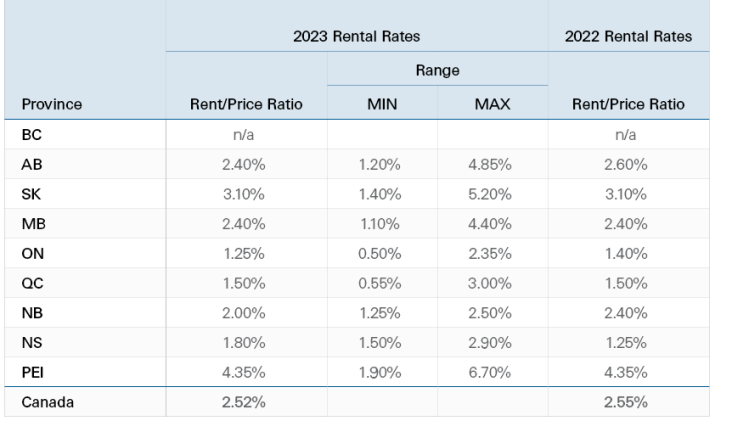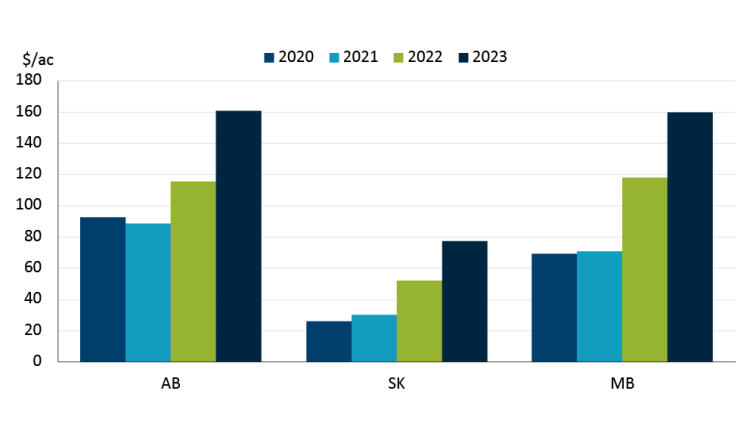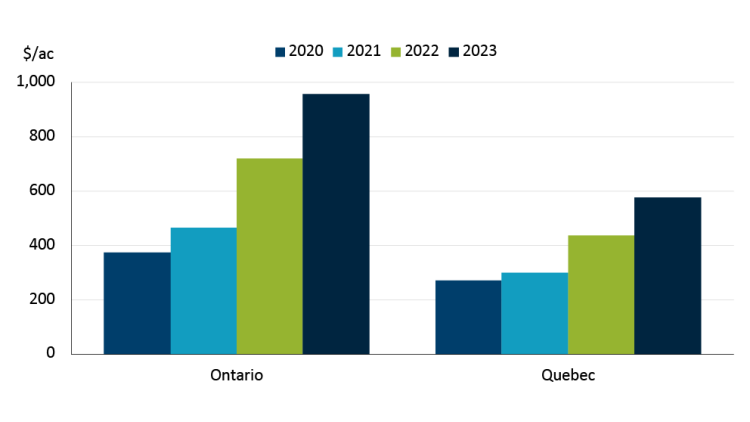2023 farmland rental rates largely unchanged, yet cash flow advantage from renting grew

The FCC Farmland values report reported farmland value increases for 2023 which raised land affordability challenges for farm operations. Generally, the cost to rent farmland is lower than financing, thus renting is a worthwhile alternative to explore in support of cash flow, while minimizing financial risk. Location is, as for any real estate decision, a key factor. With many rental agreements locked in for multiple years, recent increases in farmland values do not immediately impact the operations bottom line.
Rent to Price ratio analysis
While there are different kinds of rental agreements used in the agriculture sector; this analysis focuses on cash rental agreements.
The national RP ratio in 2023 was 2.52%, a slight decrease from 2022 (Table 1). No rates are published for British Columbia this year as data in multiple regions were deemed insufficient to provide an accurate average RP ratio.
Table 1: 2023 Rent to price ratio by province, with minimum and maximum range by province, including 2022 Rent to price ratio.

Source: FCC calculations
The largest increase in farmland values in 2023 were in Saskatchewan, Manitoba, and Quebec. With rental rates rising at a similar pace overall in those provinces the RP ratio remained stable.
In 2022, Ontario saw the highest increase in farmland values with an average 19.4% increase, with a more modest increase of 10.7% in 2023. With the RP ratio decreasing this year this indicates that cash rental rates agreements have not evolved at the same pace as farmland values.
Similar results were observed in Atlantic provinces with the rate of increase in rental agreements being lower than the rate of farmland value appreciation in both New Brunswick and Prince Edward Island. These provinces experienced higher than average increases in farmland values in 2022.
As a risk mitigation practice for renters, cash rental agreements are often negotiated for longer periods, which encourages better land stewardship. It is also important to note that there is considerable fluctuation in each province’s cash rental rates and farmland values; so only the weighted provincial and national average is disclosed here. The high-end RP ratio is usually seen on farmland with the lowest value per acre in the province. Specialty crops, like potatoes, are generally negotiated at higher prices than other crops.
Renting farmland can complement land purchases and is often part of long-term strategic growth plans. Let's look deeper at how producers can compare the annual cash flow outcomes of renting compared to purchasing.
Rent versus purchase decision
Renting may be part of the business strategic plan when an operation is looking to expand their land base and grow their operation. Buying land can tie up available capital and reduce cash flow, leaving fewer financing options for machinery, input needs or future expansion opportunities.
While there are obvious advantages of land ownership, cash flow should remain a key consideration for producers as this is tied to the ability to service debt and maintaining agility for capitalizing on opportunities. The difference in per acre profitability is generated by subtracting the cost of renting land from a newly purchased land cost, assuming a 25% downpayment and 25-year amortization length (Figures 1 and 2).
Since 2021, the three prairie provinces have seen an increased cash flow benefit from renting land compared to purchasing. In 2023 in Alberta, rented ground returned $160 per acre more than newly purchased land. The same story holds true for Manitoba as the per acre difference in profitability due to renting has doubled since 2020. Saskatchewan has also seen the advantage grow for renting over owned as well but with smaller results.
Figure 1: Per acre difference in profitability for renting vs newly purchased land in the Prairies

Sources Statistics Canada, FCC calculations
Ontario and Quebec producers have also seen higher cash flow advantages when moving to rental agreements compared to newly purchased land. Ontario’s rent advantage was 2.5 times higher in 2023 compared to 2020, while Quebec is 2.1 times higher. While the advantage of renting over financing is significant on cash flow, producers need to understand their cost of production before entering into a new land rental agreement to ensure it meets the needs of their operation.
Figure 2: Per acre difference in profitability for renting vs newly purchased land in Ontario and Quebec

Source: Statistics Canada, FCC calculations
Note this analysis uses the province wide rent to price ratio, which means the cash flow advantage that renting has over newly purchased land may look significantly different across regions.
What to expect for farmland rental rates going forward
While the financial advantage has clearly swung from financing land to renting, overall profitability for an operation depends on many factors. Ownership vs. renting remains a decision that must meet the business’s strategic objectives. Landlords also have a vested interest in seeing tenants committed to the land's long-term health. Sound risk management and collaboration between farmers and landowners are required for successful long-term partnerships.
Article by: Lyne Michaud, É.A., Senior Analyst, Valuations and Justin Shepherd, Senior Economist, Economics
